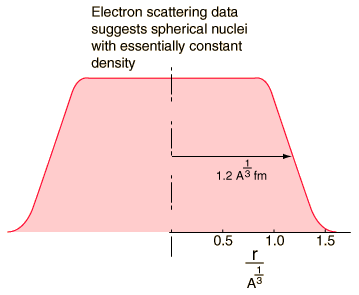Nuclear Size and Density
Various types of scattering experiments suggest that nuclei are roughly spherical and appear to have essentially the same density. The data are summarized in the expression called the Fermi model:

 |
where r is the radius of the nucleus of mass number A. The assumption of constant density leads to a nuclear density

|
The most definitive information about nuclear sizes comes from electron scattering. The comparison of calculated and experimental radii for nuclei are very sensitive to the exact onset of the overlap between the probe particle and the nuclear matter. These comparisons have made it clear that there is a "tail" where the density of nuclear matter decreases toward zero. The nucleus is not a hard sphere. Krane comments that the evidence points to a mass radius and a charge radius which agree with each other within about 0.1 fermi. Since heavy nuclei have about 50% more neutrons than protons, one might expect a mass radius larger than the charge radius. One can visualize the protons being pushed toward the outside by the proton repulsion and the neutrons being pulled inward by the neutron-proton attraction, so the observed result agrees with what one might expect with this kind of model.
|
Index
Nuclear Structure Concepts
Reference
Krane
Ch. 3 |



